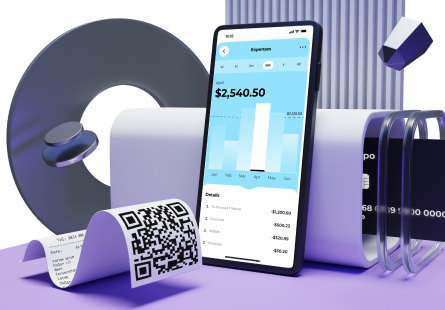Modern consumers crave convenience and flexibility at every stage of making a purchase, including checkout. By failing to provide a user-friendly customer payment solution, businesses risk losing customers and revenue.
This is where integrated payment technology can save the day. It delivers a seamless checkout experience for your customers and gives you a competitive advantage.
If you consider integrating a payment gateway into your infrastructure as part of your digital transformation, stay on this page. This guide provides a detailed look at payment gateways and their types, explores the steps to selecting the best payment system for business, and much more.
What is a payment gateway, and how does it work?
A payment gateway is a technology functioning as an intermediary between a business’s website or application and the financial institutions that process payments. It enables brick-and-mortar and online merchants to accept electronic payments from credit cards, debit cards, bank transfers, mobile wallets, and other popular payment methods. Simply put, it acts as a payment portal connecting the customer, the merchant, and financial institutions, namely the acquirer and issuer banks.
Payment gateways can be integrated with e-commerce platforms, content management systems, websites, web applications, mobile applications, POS systems, accounting and invoicing software, reservation systems, and more.
The process of conducting financial transactions via a gateway involves the following steps:
- The customer selects items on the merchant’s website or app and proceeds to the checkout page.
- The customer enters payment details, such as credit card details, into the checkout form. The payment gateway encrypts this sensitive information to ensure it’s securely transmitted over the internet.
- The encrypted payment data is sent to the payment gateway from the merchant’s website or app.
- The payment gateway forwards the authorisation request to the respective payment processor or acquiring bank, usually the customer’s bank or credit card network.
- The external payment processor or bank performs various checks, including verifying the availability of funds, checking for potential fraud indicators, and ensuring compliance with security standards.
- Based on the payment verification checks, the processor sends back an approval or rejection response to the payment gateway.
- Finally, the payment gateway forwards the response to the merchant’s website or app, informing them whether the payment was approved or declined.
- If the payment is approved, the money is transferred from the customer’s account to the merchant’s.
Types of payment gateway
There are four types of payment gateways, which differ based on how they’re integrated into a website or application. Let’s take a closer look at them.
Hosted payment gateways
When a merchant uses a hosted gateway, customers are redirected from the merchant’s checkout page to a payment page hosted by their payment gateway provider. The entire payment process, including entering payment details and completing the transaction, occurs on the provider’s site. Once the payment is processed, customers are redirected back to the merchant’s site. This method simplifies PCI compliance for merchants since they don’t handle sensitive payment information directly.
Pros
• A straightforward way to introduce digital payments without establishing direct integration with a payment network.
• Merchants don’t have to store sensitive data and acquire necessary compliance certification.
Cons
• Lengthy checkout process, which customers can find inconvenient.
• The extent of payment processing capabilities is defined by the provider and can’t be changed.
Self-hosted payment gateways
Self-hosted payment gateways are installed and hosted on the merchant’s server, meaning that customer payment details are collected directly on the merchant’s website. Unlike hosted gateways, where the payment process occurs on the gateway provider’s server, self-hosted gateways enable merchants to maintain control over the entire payment process. However, they require merchants to handle security and compliance aspects themselves.
Pros
• Complete control over customer data.
• Flexibility concerning customisation and branding of your online payment gateway.
Cons
• The merchant is entirely responsible for the protection and storage of sensitive data.
• Integration with legacy applications can be expensive and time-intensive.
API-hosted payment gateways
API-based payment gateways use APIs (Application Programming Interfaces), allowing merchants to directly integrate payment processing functionality into their mobile apps, websites, or other software systems. This type of integrated payment solution offers flexibility and customisation options, as developers can tailor the payment experience to meet specific business requirements.
Pros
• A seamless customer experience that results from the ability to finalise payments directly on a merchant’s website or app.
• The ability to customise the payment page to match your branding.
Cons
• The merchant takes full responsibility for the security of payment data.
Local bank integration gateway
A local bank integration gateway is a payment processing solution that connects merchants with local banks for payment acceptance, utilising the banking infrastructure within a particular geographic region or country. By connecting businesses directly with local financial institutions, this type of payment gateway offers lower payment transaction fees and faster settlement times. However, such systems rarely allow returns or repeat digital customer payments.
Pros
• Lower transaction fees compared to international payment networks or third-party processors.
• Faster payment processing and settlement times.
Cons
• Limited reach.
• Issues with local banking infrastructure, such as downtime or technical issues, can affect payment processing reliability.
• Local bank integration gateways may support fewer payment methods or currencies than international payment networks.
Benefits of payment gateway integration
Payment gateways offer a range of advantages that can boost operational efficiency and substantially enhance shopping experiences for your customers, ultimately providing any brick-and-mortar or online business with a solid competitive advantage.
Fast payment processing
Payment gateway integrations significantly speed up transaction processing compared to manual methods. This swiftness translates to a seamless customer checkout experience, reduced cart abandonment rates, and accelerated sales cycle for merchants.
Secure transactions
Payment gateways implement stringent security measures to protect sensitive customer information. They use high-level encryption technologies and secure protocols to safeguard data such as credit card details, ensuring they are safe from possible fraud and data breaches. Moreover, many payment gateways employ advanced tools that screen in-person and online transactions for fraudulent activity.
Improved customer experience
Payment gateways help deliver intuitive, flexible, and hassle-free shopping experiences that meet the needs of modern consumers. Payment integration allows customers to make payments conveniently across any device and location, boosting the overall user experience and ultimately leading to greater customer loyalty and increased conversion rates.
Access to global markets
Many payment gateways allow multi-currency transactions, enabling merchants to cater to customers across various geographies, which is especially valuable for businesses engaged in international commerce. In addition to elevating the shopping experience for global customers, an integrated payment gateway can greatly feed into strengthening your global expansion strategy.
Top third-party payment gateways on the market
Stripe
Stripe is one of the most popular payment service providers known for its easy API integration process. Stripe offers one-click checkout, access to over 100 payment methods, and built-in optimisation tools. This robust payment gateway solution allows businesses to expand to new markets faster and sell cross-border to over 195 countries. Stripe utilises machine learning to decrease fraud and improve authorisation rates. In addition, Stripe lets you deliver a unified commerce experience across your online and in-person stores to reward loyalty, personalise customer interactions, and grow revenue.
Authorize.net
Auhtorize.net provides major payment method support, including debit cards, credit cards, e-checks, and mobile payments. While it allows you to accept international payments from customers worldwide, your business must be based in Europe, the United States, the United Kingdom, Canada, or Australia. Authorize.net provides the lowest transaction fees for e-commerce and dropshipping stores. One of the outstanding features of Authorize.net is its round-the-clock free support with real people.
Payflow
Payflow is a popular payment gateway designed by PayPal. It comes in two versions — Payflow Link and Payflow Pro — depending on the level of customisation you expect on your checkout page. With Payflow Link, customers enter their payment details at checkout using a template hosted by PayPal. You can integrate a template embedded on your website or use a customisable full-page template. Payflow Pro is fully customisable, allowing you to control almost every aspect of your checkout. Payflow includes a basic fraud protection service at no extra fee. However, you can upgrade to an advanced fraud detection suite for an additional cost.
Square
Square offers a single payments solution for all channels, providing businesses with a complete view of their cash flows and creating better experience for their customers. According to Square, their team is committed to protecting sellers and customers. That’s why they do their best to simplify PCI compliance and provide AML and KYC checks at no extra cost. Square also has an in-house team of data scientists and risk analysts who help keep you and your customers ahead of fraud.
Helcim
Helcim is renowned as an affordable solution for small and medium businesses accepting credit card payments online or in person. The team at Helcim is focused on building long-term relationships with merchants, which they achieve by offering ultimate transparency, low rates, smart tools, and superior service. Once you sign up for a free account with Helcim, you receive access to a range of tools, including Helcim Virtual Terminal, POS App, Helcim Online Checkout, Helcim Subscription Manager, and invoicing software.
How to choose the right payment gateway for your business
Choosing the payment gateway for your business calls for careful consideration of several factors to ensure it aligns with your needs and goals.
Identify your requirements
First of all, identify your business requirements and goals. Consider payment options (credit/debit cards, digital wallets, etc.), your target market (local or international), your expected transaction volume, and specific features you need (recurring billing, mobile payments, etc.).
Explore prices
Once you have shortlisted payment solution providers according to your requirements, your next step should be understanding each payment gateway’s pricing structure, including setup fees, monthly fees, transaction fees, and any additional charges for features or services. Compare the costs of different providers and consider how they align with your budget and expected transaction volume.
Check transaction limits
Remember that gateway providers set transaction limits as a minimum and maximum amount. For instance, Stripe’s transaction minimum is $0.50, and the maximum is $999,999.99. Although it rarely occurs, some providers may also set daily or monthly transaction limits.
Assess the level of security
Ensure that your chosen payment gateway complies with security standards such as PCI DSS and offers robust encryption, tokenisation, and fraud prevention measures to protect sensitive payment data.
Consider integration compatibility
Choose a payment gateway that can seamlessly integrate with your existing e-commerce platform, website, shopping cart software, mobile application, or any other application you use. Check if the gateway offers plugins, APIs, or SDKs for easy integration.
Evaluate customer support
Estimate the quality of customer support provided by each payment gateway. Ideally, your provider should offer 24/7 support and multiple channels like phone, email, live chat, etc.
The payment gateway integration process step-by-step
As a software development company with decades of experience in fintech, DeepInspire can help you integrate a third-party payment system into your web or mobile application or other software system. Here are the key steps of this process.
1. Discovery workshop
Our integration team starts by conducting a discovery session, during which we discuss your business specifics, requirements, goals, and current infrastructure. We assess your needs and recommend suitable payment gateway solutions based on your transaction volume, target market, and other factors.
2. Selection of a payment gateway
Following the discovery session, we help you select the most appropriate payment service provider to align with your business objectives and technical requirements. Our integration team considers features, security, and pricing to ensure the chosen gateway meets your needs.
3. Merchant account setup
Once you’ve chosen a payment integration solution, we assist you in creating a merchant account with the provider, guiding you through the entire account setup process.
4. Devising your integration strategy
At this stage, our team works closely with you to develop an integration strategy tailored to your business needs, including the integration process steps, timelines, and resources needed to ensure a smooth and efficient integration.
5. Technical integration
Our experienced integration team integrates the selected payment gateway into your system using the gateway’s API or SDK.
6. Customisation and branding
Once the technical integration is complete, we proceed to customise your integrated payment gateway to ensure it aligns with your brand identity. We can customise payment forms, checkout flows, and confirmation pages to reflect your branding and enhance the user interface.
7. Testing and quality assurance
Next, we conduct rigorous payment gateway testing to ensure its functionality, security, and compatibility.
8. Deployment and training
Finally, our integration team deploys the gateway to the production environment, closely monitoring transaction activity to ensure a seamless transition. We deliver training sessions to help your team learn how to effectively use and manage your payment gateway.
9. Ongoing support and maintenance
Our partnership doesn’t end with deployment. We provide ongoing support and maintenance services to address security issues, provide updates, and optimise performance.
Bottom line
A payment gateway enables fast and secure transfer of payment information, making it a must in today’s competitive and customer-centric business environment. Our team has the necessary integration expertise, including open banking integrations, and tech stack to deliver professional services for online payment gateway integration. And if you’re looking to develop a separate payment solution for commercial use, we can help you, too. With years of experience in banking software development, the development team at DeepInspire can build custom payment gateways, from API development to payment gateway provider registration. Reach out to us to discuss your needs and goals.







